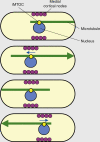Cell shape and cell division in fission yeast
- PMID: 19906584
- PMCID: PMC2997724
- DOI: 10.1016/j.cub.2009.08.012
Cell shape and cell division in fission yeast
Abstract
The fission yeast Schizosaccharomyces pombe has served as an important model organism for investigating cellular morphogenesis. This unicellular rod-shaped fission yeast grows by tip extension and divides by medial fission. In particular, microtubules appear to define sites of polarized cell growth by delivering cell polarity factors to the cell tips. Microtubules also position the cell nucleus at the cell middle, marking sites of cell division. Here, we review the microtubule-dependent mechanisms that regulate cell shape and cell division in fission yeast.
Figures



Similar articles
-
Physical mechanisms redirecting cell polarity and cell shape in fission yeast.Curr Biol. 2008 Nov 25;18(22):1748-53. doi: 10.1016/j.cub.2008.09.047. Curr Biol. 2008. PMID: 19026544 Free PMC article.
-
Fission yeast: in shape to divide.Curr Opin Cell Biol. 2012 Dec;24(6):858-64. doi: 10.1016/j.ceb.2012.10.001. Epub 2012 Nov 3. Curr Opin Cell Biol. 2012. PMID: 23127610 Review.
-
Fission yeast cytoskeletons and cell polarity factors: connecting at the cortex.Biol Cell. 2006 Nov;98(11):619-31. doi: 10.1042/BC20060048. Biol Cell. 2006. PMID: 17042740 Review.
-
Establishing new sites of polarization by microtubules.Curr Biol. 2009 Jan 27;19(2):83-94. doi: 10.1016/j.cub.2008.12.008. Epub 2009 Jan 15. Curr Biol. 2009. PMID: 19147354 Free PMC article.
-
Shaping fission yeast with microtubules.Cold Spring Harb Perspect Biol. 2009 Jul;1(1):a001347. doi: 10.1101/cshperspect.a001347. Cold Spring Harb Perspect Biol. 2009. PMID: 20066076 Free PMC article. Review.
Cited by
-
Processes Controlling the Contractile Ring during Cytokinesis in Fission Yeast, Including the Role of ESCRT Proteins.J Fungi (Basel). 2024 Feb 15;10(2):154. doi: 10.3390/jof10020154. J Fungi (Basel). 2024. PMID: 38392827 Free PMC article. Review.
-
Conserved Orb6 phosphorylation sites are essential for polarized cell growth in Schizosaccharomyces pombe.PLoS One. 2012;7(5):e37221. doi: 10.1371/journal.pone.0037221. Epub 2012 May 21. PLoS One. 2012. PMID: 22629372 Free PMC article.
-
Cells in tight spaces: the role of cell shape in cell function.J Cell Biol. 2010 Oct 18;191(2):233-6. doi: 10.1083/jcb.201009048. J Cell Biol. 2010. PMID: 20956377 Free PMC article.
-
Cytoskeletal dynamics in fission yeast: a review of models for polarization and division.HFSP J. 2010 Jun;4(3-4):122-30. doi: 10.2976/1.3385659. Epub 2010 Apr 15. HFSP J. 2010. PMID: 21119765 Free PMC article.
-
Forces that shape fission yeast cells.Mol Biol Cell. 2017 Jul 7;28(14):1819-1824. doi: 10.1091/mbc.E16-09-0671. Mol Biol Cell. 2017. PMID: 28684607 Free PMC article.
References
Publication types
MeSH terms
Grants and funding
LinkOut - more resources
Full Text Sources

